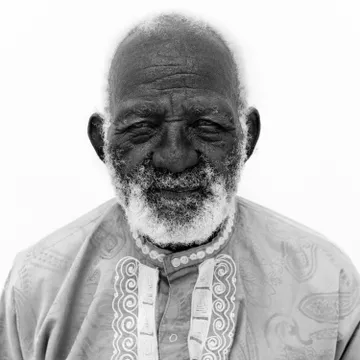Born in 1929 in Accra, capital of the British colony of the Gold Coast, which would become Ghana following the proclamation of independence in 1957, James Barnor began his career in photography in 1947.
Beginning as an apprentice in a small Accra studio belonging to his uncle, the young Barnor set out in 1949 as an independent portrait photographer. Thus was born his celebrated and evocatively-named Ever Young Studio, established in 1953 in Jamestown, one of Accra’s oldest neighborhoods, teeming with merchants, fishermen and the first marches for independence. At the same time, Barnor participated in the development of the illustrated press in Ghana as one of the first local photographers to collaborate, as early as 1951, with the Daily Graphic, launched by the Daily Mirror Group in London. Between 1953 and 1957, he photographed the independence leader Kwame Nkrumah on repeated occasions.
In 1959, two years after independence, James Barnor embarked upon a diasporic adventure, emigrating to London to further his mastery of the photographic medium. There he encountered color photography, which he adopted in his own work beginning in 1961. His photographs featured on the covers of the pan-Africanist magazine DRUM, which, from its founding in 1951, served as the voice for the South African anti-apartheid movement, before rapidly spreading across the continent through its multiple regional editions. For a DRUMcover story featuring young women of the diaspora, Barnor’s photographs, echoing his personal practice, eloquently captured the spirit of London of the Swinging Sixties. Barnor further developed his technical knowledge with studies at Medway College of Art, in Kent, and through work at Colour Processing Laboratories Ltd., England’s largest color photo lab.
On the basis of this expertise, Agfa-Gevaert approached Barnor in 1969 to become a technical ambassador to Ghana, where the company was seeking to develop new markets. Returning to Accra, Barnor helped found the nation’s first color photo laboratory and to spread Agfa’s products to southern Ghana. In 1972, he opened his second studio, Studio X23, where he resumed his work documenting the social changes coursing through the capital, feeding an abundant catalog of portraits. From social documentary to advertising commissions, by way of governmental photography under the regime of Jerry Rawlings in the 1980s, James Barnor has remained an indefatigable and unbiased witness to the movements of his nation’s history.
James Barnor’s archives offer a view onto crisscrossing worlds. Spanning from 1947 to the end of the 1980s, from Ghana to Europe and through public and private life, James Barnor’s worlds form a network where one moves continually and without contradiction from one to another. Aged 92, the photographer currently resides in London, where he spends most of his time cataloging his archives and overseeing expositions of his works, in the spirit of passing on his legacy.
With multiple exhibitions since 2010, Barnor’s body of work has inspired a new generation of artists. A major retrospective of his works was held at the Serpentine Gallery (London) in 2021, and is now traveling to the Museo d’Arte della Svizzera Italiana (Lugano, Swizerland) in 2022 and to the Detroit Institute of Arts (Michigan, USA) in 2023.
His works are held in the collections of major institutions, the likes of which include the Musée National d’Art Moderne – Centre Pompidou and the Museum of Modern Art (MoMA) in New York.

